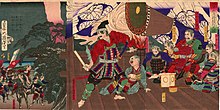
Sakai Tadatsugu
Share
Sakai Tadatsugu (酒井 忠次, 1527) was one of the most accomplished and favored military commanders in the service of Tokugawa Ieyasu in the late Sengoku period. He is considered one of the Four Guardians of the Tokugawa (Tokugawa shitennō) along with Honda Tadakatsu, Ii Naomasa and Sakakibara Yasumasa.
Genealogy of the Sakai clan
The Sakai clan, which appeared in the fourteenth century in Mikawa province, claimed descent from Minamoto Arichika. Arichika had two sons: the elder one, Yasuchika, took the name of "Matsudaira" and Chikauji, the younger one, took the name of "Sakai".
Sakai Hirochika, son of Chikauji, also has two sons and their descendants give birth to the two main branches of the Sakai clan. Tadatsugu is the heir of the senior branch of the clan.
Sakai Tadatsugu Biography
Born in 1527, Tadatsugu was the son of Sakai Tadachika, a hereditary vassal of the Matsudaira clan of Mikawa province. When Tadatsugu became an adult, he first served Matsudaira Hirotada, the father of Tokugawa Ieyasu.
After 1560, when Ieyasu cut ties with the Imagawa clan, Tadatsugu was given command of Yoshida castle4 in the east of Mikawa (present day Toyohashi).
In 1573, during the battle of Mikatagahara, Tadatsugu secured the right flank of the Tokugawa and saw his men severely beaten by the opposing forces of the Takeda.
When Ieyasu and his allies retreated to Hamamatsu Castle, Tadatsugu participated in the ruse that mitigated the effects of Takeda's victory on the field and the Takeda forces withdrew.
During the battle of Nagashino, he led a successful night attack against the Takeda.
In 1567, the majority of the daimyo forces of the Tokugawa armies were organized into two divisions, each with a separate commander. Tadatsugu was placed in command of the forces of two vassal daimyos of the Tokugawa and his counterpart, Ishikawa Kazumasa, was given command of the forces of thirteen vassal daimyōs.
Tadatsugu was also placed in command of the forces of the Tokugawa. Tadatsugu's proven qualities of loyalty, reliability, and command are clearly exemplified by this degree of delegation of power and authority.
In 1578, Sakai Ietsugu (1564-1619), Tadatsugu's son, took over his father's role as lord of Yoshida Castle. The "Ie-" at the beginning of Ietsugu's name is an honor given by Tokugawa Ieyasu, who rewards vassals who have distinguished themselves in a particular way by allowing them to use one of the kanjis of his name.
During the battle of Komaki and Nagakute, he successfully repelled a movement of Toyotomi Hideyoshi against the castle of Kiyosu led by Mori Nagayoshi, a commander of Toyotomi.
In 1590, during the Odawara campaign, Tadatsugu was ordered to accompany Tokugawa Hidetada, son and heir of Ieyasu, to Kyoto where he served as a hostage of Ieyasu's loyalty to Toyotomi during this campaign.
After the battle, Hideyoshi orders the Tokugawa clan to move from their ancestral holdings to the Kantō region. Tadatsugu retires, but his son Ietsugu receives a fudai fiefdom worth 30,000 koku in Usui, Shimōsa province, and Tadasugu accompanies him there.
Tadatsugu died in Kyoto in the early winter of 1596. After Tadatsugu's death, the Sakai clan continued to prosper.
In 1604, his descendants left the Takasaki estate (50,000 koku) in Kōzuke province; in 1616, they moved to the Takata estate (100,000 koku) in Echigo province; in 1619, they moved to the Matsushiro estate in Shinano province; and then, from 1622 until 1868, they moved to the Tsuruoka estate (120,000 koku) in Dewa province.
The head of the Sakai clan was ennobled as a "count" in the new nobility system established in the Meiji era.

